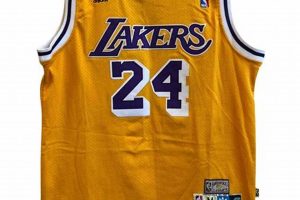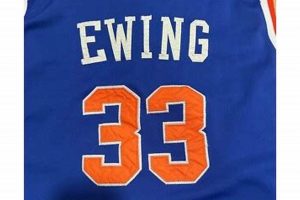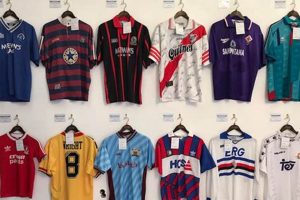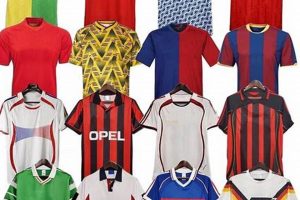Apparel from past eras of gridiron competition, often showcasing unique designs, materials, and team insignias, represents a tangible connection to football’s heritage. These items, ranging from game-worn pieces to officially licensed replicas, provide a glimpse into the evolution of athletic wear and team branding. Examples include wool jerseys from the early 20th century, nylon mesh tops from the 1970s, and early iterations of popular team logos and color schemes.
Acquiring such garments holds significant value for collectors, enthusiasts, and even fashion-conscious individuals. They offer a tangible link to specific players, teams, and pivotal moments in football history. Furthermore, they exemplify a unique aesthetic distinct from modern athletic wear, representing a bygone era. The preservation and study of these items contribute to a deeper understanding of the sport’s cultural and commercial development. Their increasing rarity contributes to their value and collectibility.
The subsequent sections will delve into specific aspects of collecting and authenticating these relics, including identifying features, valuation factors, and preservation techniques. Furthermore, we’ll explore the impact of these sought-after items on fashion and popular culture.
Tips for Assessing Vintage Football Jerseys
Evaluating apparel from football’s past requires a meticulous approach to ensure authenticity and determine value. The following guidelines offer a framework for both novice and experienced collectors.
Tip 1: Fabric Analysis: Closely examine the material. Early examples commonly feature natural fibers like wool or cotton. Later periods transitioned to synthetics such as nylon and polyester. Variations in weave and texture provide clues to the garment’s age.
Tip 2: Stitching Examination: Review the stitching quality and type. Single-needle construction is often indicative of older garments, while modern examples utilize overlock or zigzag stitching. Inconsistencies or repairs may detract from value, but original manufacturing techniques can be a sign of authenticity.
Tip 3: Tag Identification: Research historical tagging practices of sporting goods manufacturers. Tags often contain crucial information about the brand, sizing, and manufacturing location. Comparing the tag to known authentic examples is crucial.
Tip 4: Logo and Numbering Style: Scrutinize the font, placement, and application method of team logos and player numbers. Compare these details to photographic records or historical references to verify accuracy.
Tip 5: Provenance Documentation: Seek verifiable documentation, such as letters of provenance, photographs, or game programs, that support the garment’s history and authenticity. Documented provenance significantly increases value.
Tip 6: Wear and Tear Assessment: Evaluate the overall condition, noting wear patterns, staining, and damage. While some wear is expected in older items, excessive damage may indicate neglect or improper storage.
Tip 7: Professional Authentication: Consider consulting with a reputable sports memorabilia authenticator for expert evaluation. Their expertise can provide assurance and prevent costly errors.
Applying these steps aids in informed decision-making, whether one is acquiring items for personal enjoyment or investment purposes. Thorough evaluation safeguards against counterfeits and maximizes the potential value of collections.
The concluding sections will explore the marketplace dynamics of these sought-after relics, covering topics such as auction trends, collector communities, and long-term value appreciation.
1. Material composition
The identification of fabric types represents a primary step in authenticating and dating apparel from football’s past. Material analysis provides crucial insights into manufacturing techniques and available textiles during different periods, thereby guiding assessments of legitimacy.
- Early Natural Fibers (Pre-1950s)
Wool and cotton were dominant materials in the early years of football. Wool offered durability and warmth but was heavy and prone to shrinking. Cotton was lighter but less durable. Examining the weave and texture of these fabrics helps determine if the piece aligns with the timeframe. For example, a heavy, coarse wool jersey with leather reinforcements suggests an origin in the early to mid-20th century.
- Transitional Synthetics (1950s-1970s)
Nylon and rayon began to appear, offering lighter weight and improved moisture resistance compared to natural fibers. However, these early synthetics often had a distinctive sheen and feel. The presence of these materials indicates a piece likely originated during this transition period. A jersey featuring a blend of cotton and nylon could point to the late 1960s or early 1970s.
- Polyester Era (1970s-1990s)
Polyester became the standard due to its durability, wrinkle resistance, and colorfastness. Mesh polyester fabrics provided ventilation. Evaluating the specific weave and weight of the polyester can help narrow down the production year. A double-knit polyester jersey, for example, is characteristic of the 1970s.
- Modern Blends (1990s-Present)
Microfibers and advanced polyester blends offer enhanced performance characteristics like moisture wicking and stretch. These materials often have a smoother texture and more vibrant colors. A jersey made with a moisture-wicking polyester fabric is likely a product of the late 1990s or later.
In summary, a careful analysis of fabric composition, coupled with an understanding of historical textile trends, is essential for validating the authenticity and determining the age of football apparel. Discrepancies between the materials used and the supposed era of the jersey can indicate a reproduction or a fabrication.
2. Stitching techniques
Examination of stitching methods represents a critical aspect of authenticating apparel from football’s past. Variations in stitch type, density, and thread composition provide valuable clues regarding the garment’s age and manufacturing origin.
- Single-Needle Stitching
Single-needle stitching, characterized by a single line of stitching on both sides of the fabric, was common in early garments due to limitations in manufacturing technology. Its presence often indicates production prior to the widespread adoption of multi-needle machines. Examining the consistency and tension of the stitch can further aid in dating the item. Imperfections in the stitching are more common, reflecting the manual nature of the process.
- Chain Stitching
Chain stitching, identifiable by its looped appearance on one side of the fabric and a straight stitch on the other, was often used for applying numbers and lettering. This technique offered durability and a distinctive aesthetic. Analysis of the chain stitch’s uniformity, loop size, and thread type can help verify the garment’s period authenticity.
- Zigzag Stitching
Zigzag stitching emerged with the development of advanced sewing machines. Its use on football jerseys typically indicates a later production date, generally post-1950s. Evaluating the width, density, and pattern of the zigzag stitch provides additional insights into the garment’s era and manufacturing standards.
- Overlock Stitching
Overlock stitching, which encases the fabric edge with thread to prevent fraying, is a hallmark of modern garment construction. Its presence on football jerseys often suggests a more recent manufacturing date, typically post-1970s. Examining the number of threads used and the stitch density can help differentiate between different periods and manufacturing processes.
Understanding these stitching variations enables collectors and historians to better assess the authenticity and period of football apparel. Inconsistencies between stitching techniques and the garment’s purported age raise red flags and warrant further investigation. Cross-referencing stitching patterns with known examples and historical manufacturing practices strengthens the validation process.
3. Tagging consistency
Tagging consistency serves as a critical factor in authenticating football apparel from past eras. Discrepancies in tagging can indicate reproductions, unauthorized alterations, or misrepresentations of a garment’s origin. Thorough examination of labeling practices is essential in the valuation process.
- Brand Identification and Era
Sporting goods manufacturers utilized specific tags to identify their products and indicate the production period. Each brand had its own distinctive style, font, and logo. For example, a Spalding tag from the 1930s would differ significantly from a Sand-Knit tag from the 1970s. Comparing the tag to known examples from historical catalogs and advertisements is essential.
- Size and Material Information
Tags typically included information regarding the garment’s size and material composition. These details must align with the known characteristics of jerseys from the purported era. For instance, the absence of a size designation or an inaccurate material listing (e.g., a polyester tag on a jersey claimed to be from the 1940s) would raise suspicion.
- Manufacturing Location and Union Labels
Many tags featured information about the manufacturing location and the presence of union labels. These details provide insights into the labor practices and trade regulations of the time. For example, a “Made in USA” label combined with a union bug can assist in dating the garment and verifying its authenticity within the context of US-produced sportswear.
- Variations and Evolutions
Tagging practices evolved over time, with manufacturers updating their designs and incorporating new information. Collectors must be aware of these variations and understand how to interpret them. A gradual shift in font style or the addition of a care instruction symbol can provide clues about the garment’s production timeline.
Tagging consistency, when rigorously assessed, enhances the accuracy of appraisal and provides invaluable insights into the historical context of vintage football apparel. The presence of verifiable tags, aligned with manufacturing records and industry standards, reinforces the authenticity and value of collected items.
4. Logo accuracy
Verification of logo design is paramount in evaluating apparel from historical football seasons. Accurate representation of team insignias and league emblems directly impacts both the authenticity and the market value of such items. Deviations from established designs introduce doubts regarding legitimacy and historical accuracy.
- Design Evolution and Chronological Correctness
Team logos often undergo revisions over time. Matching the logo design to the specific era the apparel is claimed to represent is essential. For instance, utilizing a logo that was not adopted until the 1990s on a jersey supposedly from the 1970s immediately indicates an inconsistency. Historical records, team archives, and sporting goods catalogs serve as essential resources for verifying design chronology.
- Color Fidelity and Application Method
The accuracy of colors used in team logos must correspond to the official team colors of the period. Faded or inaccurate colors can suggest either age-related degradation or the use of non-official materials. The method of logo application, whether screen-printed, embroidered, or appliqued, should also align with the techniques prevalent during the garment’s alleged era. A heat-transferred logo on a jersey purportedly from the 1940s would be incongruous.
- Proportional Accuracy and Placement
The proportions of a team logo, including the relative sizes and positions of its constituent elements, must adhere to the standards established by the team and its licensees. Discrepancies in proportion or placement can indicate unauthorized reproductions or alterations. Careful comparison with photographic evidence and officially licensed merchandise from the relevant period is necessary.
- Licensing and Trademark Compliance
Authentic items typically display evidence of licensing agreements with the relevant sports league or governing body. The presence of a trademark symbol () or a copyright notice () near the logo indicates that the design was officially protected and authorized for commercial use. The absence of such indicators, particularly on items claimed to be officially licensed, warrants further scrutiny.
In conclusion, meticulous evaluation of logo accuracy, encompassing design evolution, color fidelity, proportional correctness, and licensing compliance, serves as a cornerstone in authenticating football apparel from past seasons. Such verification processes mitigate the risk of acquiring counterfeit or misrepresented items, ensuring the preservation of historical integrity.
5. Provenance documentation
The verifiable history of ownership and origin, known as provenance documentation, represents a cornerstone in authenticating and valuing apparel from past football seasons. This documentation establishes a direct link between the item and its historical context, substantiating claims of authenticity and enhancing its desirability among collectors.
- Ownership Chain Verification
A clear and unbroken chain of ownership, traced from the original owner (e.g., a player or team personnel) to the current possessor, provides compelling evidence of authenticity. Documentation may include bills of sale, letters of transfer, or notarized affidavits from previous owners. Each transfer should be thoroughly investigated and corroborated to eliminate any gaps or inconsistencies. A jersey with a fully documented ownership history commands a higher premium due to the reduced risk of fraud.
- Photographic and Video Evidence
Visual records depicting the item in use or associated with a specific event provide strong corroboration. Photographs or video footage of a player wearing the jersey during a game, practice, or public appearance can establish a direct link between the item and its purported history. Such visual evidence is particularly valuable when combined with other forms of documentation, such as game programs or team yearbooks. The existence of such records drastically increases the item’s verifiable authenticity.
- Game Use Authentication
Documentation confirming the garment was worn during a specific game adds significant value and historical importance. Game programs, newspaper articles, or team-issued certificates can substantiate such claims. Detailed analysis of game photographs may reveal unique characteristics of the item, such as repairs or specific wear patterns, further confirming its game-used status. Items attributed to significant games or milestones in a player’s career garner substantial interest from collectors.
- Affidavits and Expert Testimonials
Signed affidavits from individuals with direct knowledge of the item’s history, such as former teammates, coaches, or team historians, can provide credible evidence to support its authenticity. Expert testimonials from reputable sports memorabilia authenticators carry considerable weight in the valuation process. These statements should be carefully scrutinized for any potential biases or conflicts of interest. Supporting affidavits from multiple independent sources strengthen the overall claim of authenticity.
The presence of comprehensive and verifiable provenance documentation substantially elevates the credibility and value of apparel from historical football seasons. Conversely, the absence of such documentation necessitates increased scrutiny and may significantly diminish the item’s market appeal. Prospective collectors should prioritize items with well-established provenance to minimize the risk of acquiring misrepresented or counterfeit pieces.
Frequently Asked Questions
The following addresses common inquiries pertaining to the identification, authentication, and valuation of apparel from football’s past. The intent is to provide clarity on prevailing misconceptions and complexities within the area of sports memorabilia collecting.
Question 1: How can one differentiate between an authentic vintage jersey and a reproduction?
Authenticity verification requires meticulous examination of fabric composition, stitching techniques, tagging details, logo design, and provenance documentation. Reputable authentication services offer professional evaluation to distinguish genuine articles from imitations.
Question 2: What factors most significantly influence the valuation of apparel from past football seasons?
Key determinants include the item’s condition, rarity, historical significance, and provenance documentation. Items associated with notable players, teams, or events command a premium in the marketplace.
Question 3: How should one properly store and preserve garments from past football seasons to prevent deterioration?
Proper storage entails climate-controlled environments, acid-free archival materials, and protection from direct sunlight and pests. Professional conservation services offer specialized cleaning and restoration for delicate or damaged items.
Question 4: Are game-worn articles inherently more valuable than commercially available replicas?
Game-worn items generally command higher prices due to their direct association with specific players and events. However, the authenticity and provenance of game-worn items must be rigorously verified.
Question 5: How does the presence or absence of a manufacturer’s tag impact the valuation of vintage football apparel?
The presence of a correct and legible manufacturer’s tag, corresponding to the garment’s purported era, typically enhances value. The absence of a tag does not automatically invalidate authenticity, but necessitates more extensive verification through other means.
Question 6: What resources are available for researching the historical accuracy of team logos and uniform designs?
Team archives, sporting goods catalogs, historical photographs, and online databases offer valuable resources for verifying logo designs, color schemes, and uniform styles from various eras.
In summary, acquiring and maintaining items from past football seasons requires due diligence, historical research, and an understanding of authentication protocols. Consulting with experienced collectors and appraisers further aids informed decision-making.
The subsequent section will explore the ethical considerations surrounding the acquisition and sale of these unique historical artifacts.
Conclusion
This exploration has underscored the intricate facets involved in collecting and authenticating garments from past football seasons. From material composition to provenance documentation, each detail contributes to determining both the historical accuracy and the market value of these artifacts. Diligence in verification, historical research, and expert consultation remain paramount in safeguarding against misrepresentation and fraud within this market.
The acquisition and preservation of “vintage football jerseys” transcends mere collecting; it represents a commitment to preserving the tangible legacy of the sport. Understanding the nuances discussed herein fosters responsible stewardship of these historical artifacts, ensuring their appreciation by future generations. Continued research and ethical practices are vital for maintaining the integrity of this collecting field and honoring the heritage of football.







